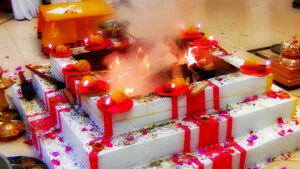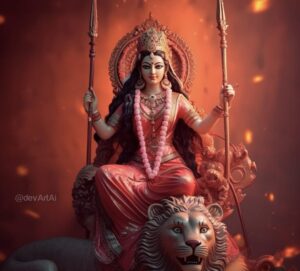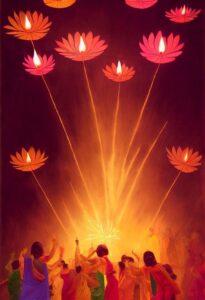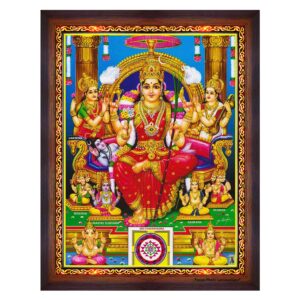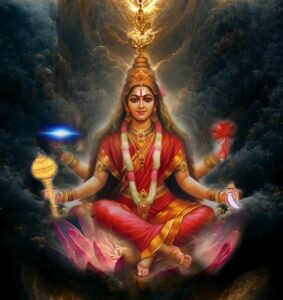Goddess Lalitha, also known as Sri Lalitha Tripura Sundari, is a divine manifestation of Shakti—the primordial cosmic energy. She embodies the essence of creation, preservation and destruction. Her form represents the highest state of consciousness and beauty, transcending all limitations. Lalitha Devi is adored as the Universal Mother and worshipped with deep reverence.
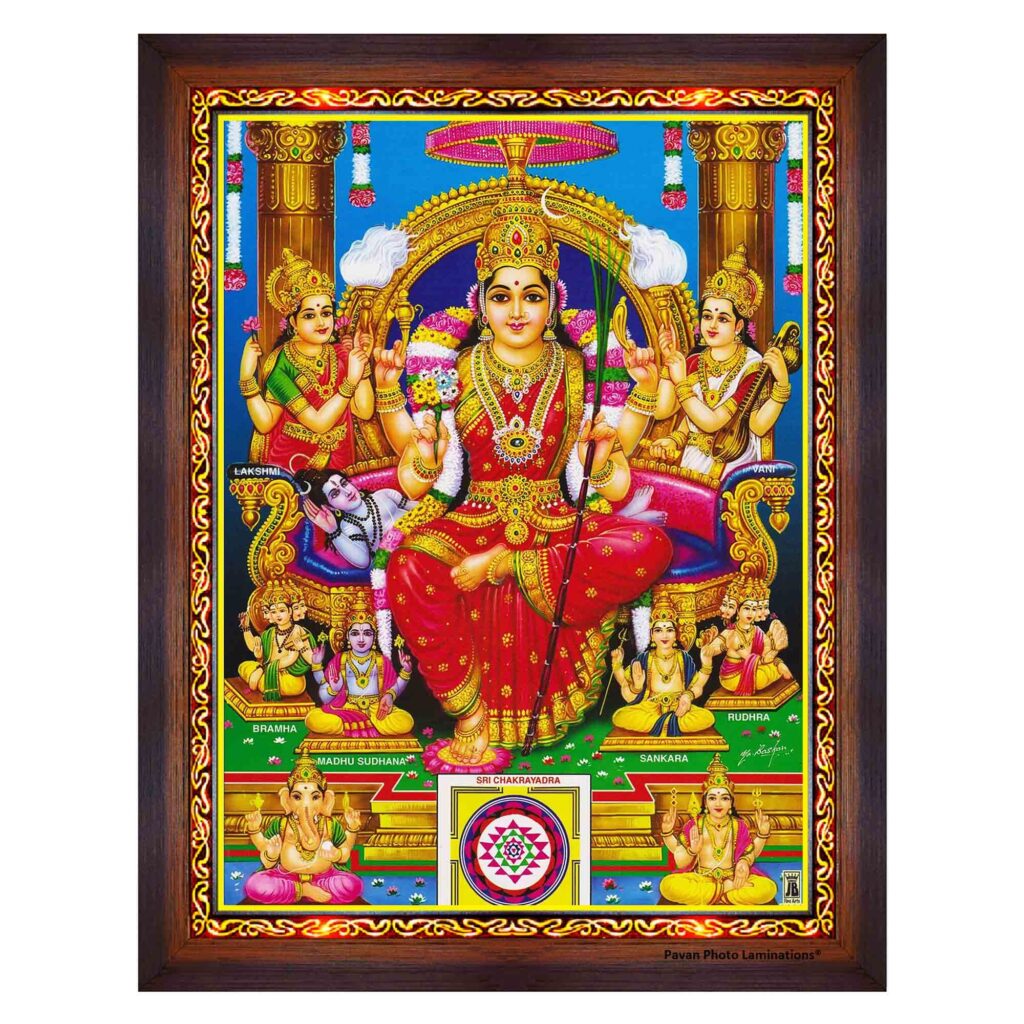
Appearance:
The Divine Beauty of Goddess Lalitha: Imagine a celestial being of exquisite beauty, with luscious, fragrant hair scented like Champak, Asoka, and Punnaga flowers. Her forehead adorned with a musk tilaka, her eyes, like fish playing in crystalline lakes, and her nose shining brighter than stars. Sun and moon studs grace her ears, and her cheeks reflect the radiant hues of the Padma raga. Her teeth form an enchanting row as she chews Thamboola with camphor, and her voice is sweeter than Saraswati’s Veena. Her smile is so captivating that even Lord Shiva himself couldn’t look away. Adorned with Mangala soothra and necklaces adorned with shining pendants, her very presence is irresistible.
The Tale of Goddess Lalitha: In ancient times, a formidable demon named Taraka threatened to engulf the Universe with his unmatched power. The devas knew that only Lord Skanda could kill him. But Lord Siva, engaged in deep meditation, delayed Skanda’s birth. To awaken Lord Siva, Manmata, the God of love, resorted to a rather unconventional method by launching arrows of lust at him. An uncontrollable fury engulfed Siva and he reduced Manmata to ashes with the energy of his Third eye. Yet, from that very Third eye emerged another force – Lord Skanda, who ultimately defeated Tarakasura.

However, without Manmata’s presence, creation itself came to a halt. Realizing this, Lord Siva bestowed Manmata with a second chance at life. As Lord Siva sprinkled holy water over Manmata’s ashes, a new demon, Banasura, came into existence by accident. This powerful demon disrupted the harmony of the three worlds. Indra, the king of Devas, turned to Lord Siva for guidance and together, they initiated a yagna. The result of this yagna was nothing short of extraordinary – the birth of Devi Sree Lalitha, the embodiment of creative, protective, and destructive powers. She was hailed as the Universal Mother and Lord Siva, in his Kameshwara avatar, married her. The kingdom of Sree Lalitha was established in Sreepura, an enchanting city atop Mount Meru, designed in the image of the Sree Chakra. A fierce and protracted battle followed, ultimately leading to Banasura’s defeat.
Method of Worship:
Devotees worship Lalitha Devi with utmost devotion, often through the recitation of Lalitha Sahasranama—a hymn that comprises a thousand sacred names of the Goddess. This recitation is considered highly meritorious. Lalitha Devi is often depicted seated on a lotus, signifying purity.
Mantras to Chant with Translations:
- Om Aim Hreem Shreem Sri Lalitha Tripura Sundari Namaha: This mantra is a salutation to the Goddess, invoking her blessings.
- Ya Devi Sarva Bhuteshu, Shakti Rupena Samsthita: This line is part of a popular invocation and acknowledges the Goddess’s presence in all beings as the universal Shakti.
- Om Shri Lalithambikayai Namaha: This mantra honors Goddess Lalitha, addressing her as the Divine Mother.
Deeper Wisdom in the Story: The narrative goes beyond its mythological elements and delves into profound philosophical themes. It speaks of the perils of arrogance, represented by Daksha, which often blinds individuals to their inner divinity. It narrates the tragedy of Sati, Daksha’s daughter, symbolizing the disregard of inner truth and divinity. The awakening of desire (Manmatha) and its subsequent control by Lord Siva’s third eye mirror the human struggle against unrestrained desires and the anger stemming from unfulfilled cravings. The story beautifully portrays the path of elevating one’s consciousness from worldly desires and anger to the attainment of inner bliss. This process symbolizes the union of Shakti and Shiva within us.
Significance of Sree Lalitha Sahasranama: Chanting the Sahasranama hymn is an act of profound significance:
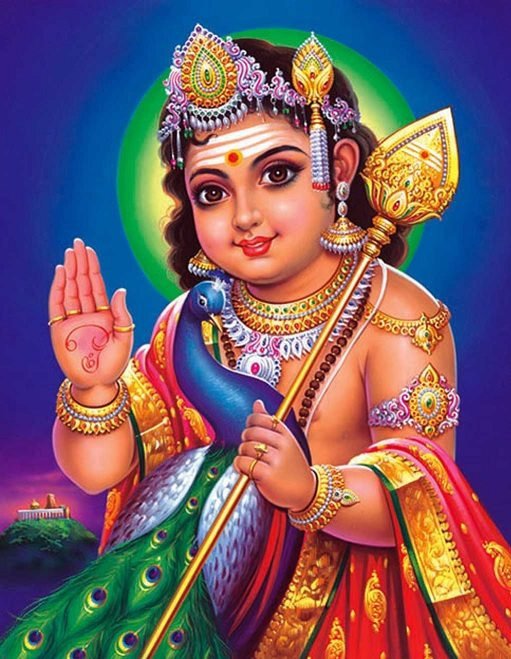
- It pleases Goddess Lalitha like nothing else and holds an unrivaled place in the Vedas and Tantras.
- The daily practice is akin to purifying oneself in holy rivers and offering abundant gifts of wealth, food, land, and cows.
- It possesses the power to bless barren women with the gift of motherhood through ghee sanctified by the Sahasranama.
- The sacred hymn has the ability to dispel the effects of evil spells, correct ritual errors and serve as an alternative to various expiatory rituals.
- It offers protection against planetary influences and adversaries, ensuring victory even in the face of daunting battles.
- Regular chanting enhances prosperity, eloquence, and fame.
- Whether in the stages of student life (brahmacharya) or renunciation (sannyasa), the Sahasranama is suitable for all.
- Through yagnas dedicated to the Lalitha Sahasranama, it fortifies the foundations of dharma, even in the challenging Kali Yuga.
- Above all, pleasing Goddess Lalitha without the chanting of her Sahasranama is a formidable task. This divine hymn has the power to cleanse the soul of sins amassed over countless lifetimes.
This mesmerizing journey through the story and significance of Sri Lalitha Sahasranama brings to life the timeless wisdom and power of the Divine Mother, Goddess Lalitha, revealing profound truths about inner divinity and the path to blissful enlightenment.
